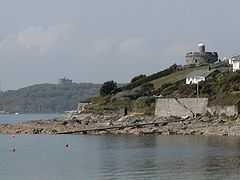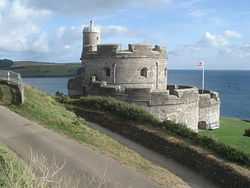St Mawes Castle
| St Mawes Castle | |
|---|---|
| Falmouth, Cornwall, England | |
|
St Mawes Castle | |
 St Mawes Castle | |
| Coordinates | 50°09′17″N 5°01′26″W / 50.15486°N 5.02377°W |
| Type | Device Fort |
| Site information | |
| Owner | English Heritage |
| Open to the public | Yes |
| Condition | Survives with later modifications |
| Site history | |
| Built | 1540 – 1545 |
| Built by | Thomas Treffry |
St Mawes Castle (Cornish: Kastel Lannvowsedh)[1] and its larger sister castle, Pendennis, were built as part of a defensive chain of fortresses by Henry VIII to protect the south coast of Cornwall, England, United Kingdom. This chain of coastal fortifications are known as Henrician Castles or Device Forts. St Mawes Castle was built between 1540 and 1545, halfway down the hillside on the eastern shore of the River Fal estuary to provide protection to the large inland expanse of water known as the Carrick Roads, near Falmouth.
History
St Mawes castle is a Device fort built between 1540 and 1545 as part of Henry VIII's south coast fortifications.[2] Together with its sister castle at Pendennis, St Mawes defended the approaches to Carrick Roads, one of the largest natural harbours in the country.[3] It was built just above an earlier fortification dating to the late 1530s.[2] The building work was supervised by Thomas Treffry, who supervised the building of Pendennis Castle at about the same time.[4] St Mawes was constructed with a central tower overlooking three huge circular bastions attached on the sides in a clover leaf pattern, providing a wide area for gun placements, with gun ports covering every angle of approach to the estuary. The clover-leaf plan was originally designed to mount "ship-sinking" guns.[2] The castle was occupied by the Royalists in the English Civil War, but it was not defensible from land attack, and it surrendered to Parliamentary forces in 1646.[2] In the late 17th century a lead-covered dome (cupola) was added to the castle's stair turret as a navigational aid or daymark.[2]
At the end of the 18th century, a lower gun battery beneath St Mawes castle was built during the Napoleonic Wars – it was armed with twelve guns and built with three flanks.[5] In about 1870, the battery was armed by four 64 pounder guns, but the battery was remodelled in 1898 to house two 6 pounder quick-firing guns and a heavy machine gun.[5] These were served by a new underground magazine situated beneath the battery.[5] The lower battery was superseded by a more powerful battery built on higher ground by 1903.[5] During World War II, the battery was part of an extensive system of defences set up on the headland.[5]
See also

References
- ↑ Place-names in the Standard Written Form (SWF) : List of place-names agreed by the MAGA Signage Panel. Cornish Language Partnership.
- ↑ 2.0 2.1 2.2 2.3 2.4 St Mawes Castle, Pastscape, retrieved 13 April 2012
- ↑ Pendennis Castle, Pastscape, retrieved 13 April 2012
- ↑ History and Research: St Catherine's Castle, English Heritage, retrieved 13 April 2012
- ↑ 5.0 5.1 5.2 5.3 5.4 Lower Gun Battery, Pastscape, retrieved 13 April 2012
Further reading
- Colvin, H. M. (ed) (1982) The History of the King's Works, Vol. IV, 1485-1600, Part II. London: HMSO
- Fry, Plantagenet Somerset (1980) The David & Charles Book of Castles. Newton Abbot: David & Charles ISBN 0-7153-7976-3
- Harrington, Peter (2007) The castles of Henry VIII. Oxford: Osprey ISBN 978-1-84603-130-4
- Jenkins, Stanley C. (2007) "St. Mawes Castle," Fort (Fortress Study Group), Vol. 35, 2007, pp. 153–172
- Linzey, Richard (1999) The Castles of Pendennis and St. Mawes. London: English Heritage ISBN 1-85074-723-7
- Morley, B. M. (1976) Henry VIII and the Development of Coastal Defence. London: H.M. Stationery Office ISBN 0-11-670777-1
External links
| Wikimedia Commons has media related to St Mawes Castle. |
- Read a detailed historical record of St Mawes Castle
- St Mawes Castle information at English Heritage
| ||||||||||||||
